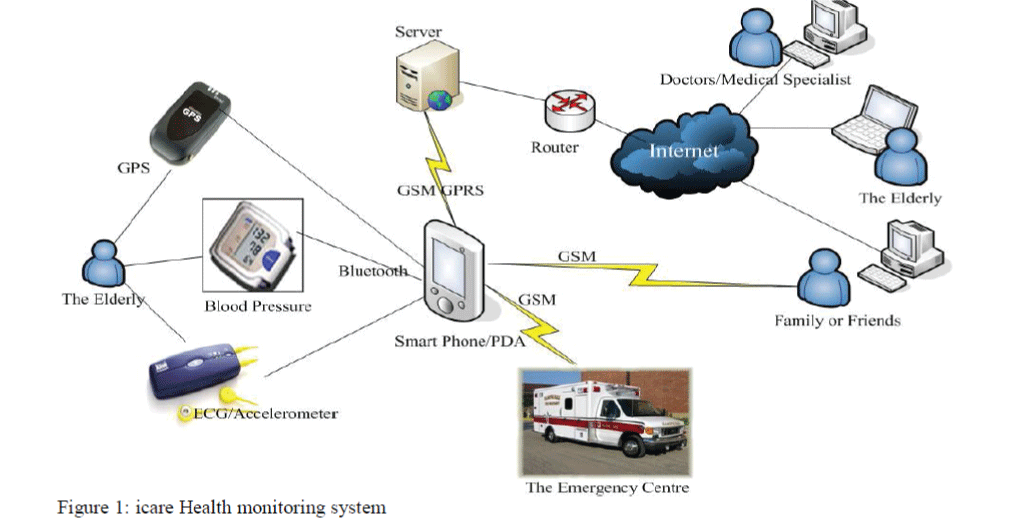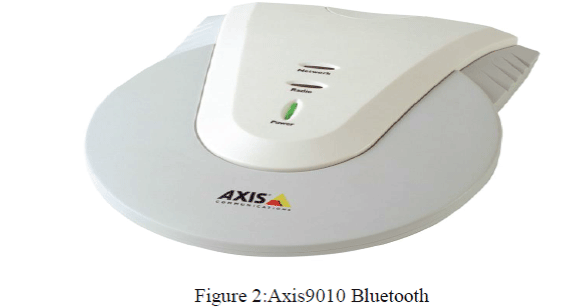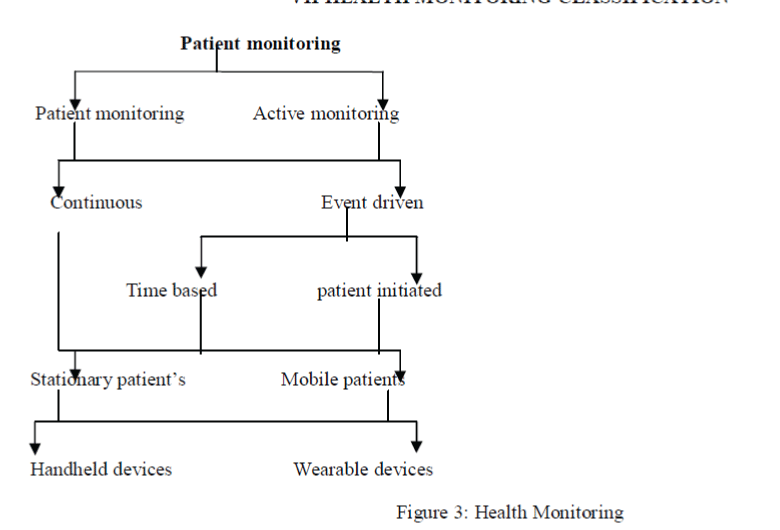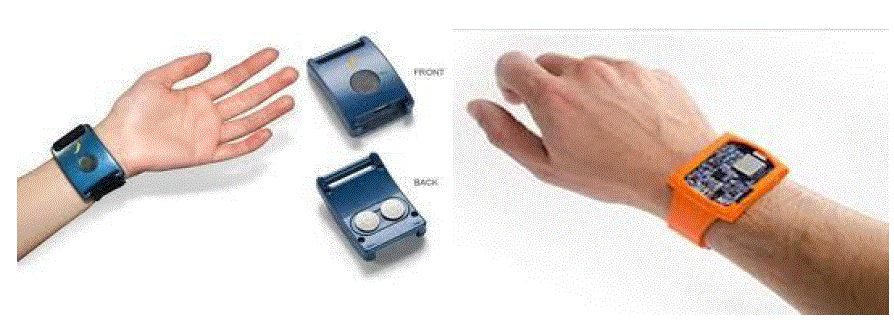Keywords
|
| Health monitoring, aging, Wireless sensors. |
INTRODUCTION
|
| Due to the huge number of elderly population worldwide, many health and government organizations are focusing on their quality of life from medical, social, and physiological points of view. According to the World Health Organization (http://www.who.int/), there will be 1.2 billion people aged 60 or above by 2025 and 2 billion by 2050. So it is utmost important that we continue working with these groups of population, who are somehow dependent and vulnerable in different aspects. As the number of elderly people in our society increases so does the need for assistive technology in the home. Elderly people run into all sorts of barriers in performing their daily routines as they get older. Activities of daily living (ADLs), such as bathing, toileting and cooking, are good indicators of the cognitive and physical capabilities of elderly. The ageing process is of course a biological reality which has its own dynamic, largely beyond human control. However, it is also subject to the constructions by which each society makes sense of old age. In the developed world, chronological time plays a paramount role. The age of 60 or 65, roughly equivalent to retirement ages in most developed countries is said to be the beginning of old age. Aging is biochemical or cellular damage. Here we are analyzing what is meant by medical age? Whether the person is medically not good (affected by some disease), those persons we may called as antiquated peoples (AP). How we can classify the age as follows: |
| a) Achievement age the age of a person expressed as the chronologic age of a normal person showing the same proficiency in study. |
| b) Bone age osseous development shown radio graphically, stated in terms of the chronological age at which the development is ordinarily attained |
| c) Chronological age the measure of time elapsed since a person's birth. |
| d) Fertilization age the age of a conceptus defined by the time elapsed since fertilization. |
| e) Gestational age the age of a conceptus or pregnancy; in human clinical practice, timed from onset of the last normal menstrual period. Elsewhere the onset may be timed from estrus, coitus, artificial insemination, vaginal plug formation, fertilization, or implantation |
| f) Mental age the age level of mental ability of a person as gauged by standard intelligence tests. |
| A Medical Test tips for all ages |
| Health screenings are important to detect cancer, hypertension (high blood pressure), diabetes and other diseases before you have symptoms in your body. |
| The following health screenings are recommended for men and women beginning at age 18 |
| Skin exams, for detection of skin cancers; self-exam monthly, looking for mole or other skin growth that changes in color, size or texture; clinical exam every three years, Blood pressure checks at least every two years, Cholesterol, blood test every five years, Chlamydia, a sexually transmitted infection; urine sample once the person is sexually active and annually until age 25 Vision and dental exams, for detection of cataracts, glaucoma, cavities, gum disease; at least annually; dentists recommend dental exams every six months, Tetanus booster, to increase immunity against tetanus; immunization beginning in high school, then every 10 years. |
Beginning at age 40:
|
| Fasting plasma glucose, for detection of diabetes |
| Blood test every three years |
Beginning at age 50:
|
| Colonoscopy, for detection of colon cancer; outpatient procedure every 10 years. |
| Beginning at age 65: |
| Bone mineral density, for detection of osteoporosis; X-rays taken as needed |
For men only beginning at age 18:
|
| Testicular exam, for detection of testicular cancer; self-exam monthly, checking for bumps or abnormalities of the scrotum and testicles; clinical exam annually. |
| The above tests are important for the above age group and it’s very useful for health monitoring systems. |
II HEALTH MONITORING SYSTEM
|
| We passionately dedicated to help medical fraternity to find health status of vital organs of the patient’s body at early stage and treat them effectively by introducing innovative and high quality hand carried non invasive health care systems and devices. “Repeated or continuous observations or measurements of the patient, his or her physiological function, and the function of life support equipment, for the purpose of guiding management decisions, including when to make therapeutic interventions, and assessment of those interventions” [1] A patient monitor may not only alert caregivers to potentially life-threatening events; many provide physiologic input data used to control directly connected life-support devices. |
| B Discipline in patient care |
| Patient care is a multidisciplinary process centered on the care recipient in the context of the family, significant others, and community. |
| 1. Physician: diagnose diseases, prescribe appropriate medications, and authorize other care services. |
| 2. Nurse: assess patient’s understanding of his/her condition and treatment and his/her self-care abilities and practices; teach and counsel as needed; help patient to perform exercises at home; report findings to physician and other caregivers. |
| 3. Nutritionist: assess patient’s nutritional status and eating patterns; prescribe and teach appropriate diet to control blood pressure and build physical strength. |
| 4. Physical therapist: prescribe and teach appropriate exercises to improve strength and flexibility and to enhance cardiovascular health, within limitations of arthritis. |
| 5. Occupational therapist: assess abilities and limitations for performing activities of daily living; prescribe exercises to improve strength and flexibility of hands and arms; teach adaptive techniques and provide assistive devices as needed. |
III i CARE
|
| In this paper describes a mobile health monitoring system called iCare for the elderly. They used wireless body sensors and smart phones to monitor the wellbeing of the elderly.[7] It can offer remote monitoring for the elderly anytime anywhere and provide tailored services for each person based on their personal health condition. When detecting an emergency, the smart phone will automatically alert preassigned people who could be the old people's family and friends, and call the ambulance of the emergency centre. The system also features some unique functions that cater to the living demands of the elderly, including regular reminder, quick alarm, medical guidance, etc. iCare is not only a real-time health monitoring system for the elderly, but also aliving assistant which can make their lives more convenient and comfortable. In this mobile care system there is network failure like router problem, protocol problem means it’s difficult the elderly person may not be contacted to other person. |
IV BLUETOOTH HEALTH MONITORING
|
| Home based health monitoring system we can use Bluetooth because of short-range communications for in-home patient location tracking, and the location information can then be recorded in a local database.[8] In this system access point stored the information; later the raw data obtained from the Bluetooth APs is forwarded to a local database along with timestamps. The stored location information of a patient is to be transmitted from the local database via the Internet to his medical practitioner for remote diagnosis, and this information transfer is performed on a daily basis. The medical practitioner can then compile the information of the patterns of the target patient’s daily routine, and a set of desired behavioral patterns can be procured |
V U –HEALTH CARE
|
| The goal of the U-Health smart home is to help the elderly to continue to live a more independent life as long as possible in their own home while being monitored and assisted (as much as possible) in an unobtrusive manner. Monitoring is done by a self-managed intelligent system capable of handling in autonomic way situations that are usually handled by humans.[10] The U-Health smart home is connected via broadband Internet access to back-end health-care providers (e.g., hospitals and specialized institutions) who are continuously informed about the status of the monitored inhabitant for handling emergency situations that necessitate their intervention. The U-Health smart home will provide the inhabitants with a large range of health and safety services that can be upgraded from time to time. The Researchers realize the full potential of the initiative is the lack of availability of biomedical sensors that are small, reliable, sensitive, and inexpensive. This is a challenge that the Health monitoring community can take head-on since it has the materials, processes, tools, and the interdisciplinary knowledge to develop low cost biosensors. |
VI VIRTUAL CAREGIVER (Vicare)
|
| The primary goal of the proposed ViCare framework is to support monitoring of the elderly person from health and wellbeing perspective by means of a virtual assistance system called ViCare. ViCare as a medium of providing elderly services that can reduce load, both cognitive and physical, of a Human caregiver.[2] A ViCare can provide a wide range of services and interact in different modes, depending on the degree of disability, economic situation, and living environment of the older person. [3] Based on the sensory data processing and situation analysis, the ViCare either invokes some services relevant to the current context and elderly activity, send message for external service initiation, intervene Human caregiver or perform any combination of these activities. In this system distributed sensing data processing is difficult. |
| Health monitoring system classified into different levels as mentioned in Figure 3.In the patient monitoring system specifically we concentrate on remote patient monitoring (RPM).It’s a technology to enable monitoring of patients outside of conventional clinical settings (e.g. in the home), which may increase access to care and decrease healthcare delivery costs.[5] Its improve the individuals quality of life and also It allows patients to maintain independence, prevent complications, and minimize personal costs. System health monitoring is a key feature for failure prevention and condition based maintenance. A health monitoring system needs to detect a fault or failure in a timely manner so that the faulty components can be replaced effectively to ensure system normal operations. The monitoring is based on sensor instruments and does not interrupt normal operation. In the next section we discussed about basics of sensors also. |
VIII SENSOR NETWORK
|
| Mainly sensor (wireless) can be used for two types of applications: Tracking and monitoring. Monitoring applications include indoor/outdoor environmental monitoring, health and wellness monitoring, power monitoring, inventory location monitoring, factory and process automation, and seismic and structural monitoring. Tracking applications include tracking objects, animals, humans, and vehicles. |
| Recent advances in wireless communications and electronics have enabled the development of low cost, low-power, multifunctional sensor nodes that are small in size and communicate untethered in short distances. [11]These tiny sensor nodes, which consist of sensing, data processing, and communicating components, leverage the idea of sensor networks. Sensor networks represent a significant improvement over traditional sensors. |
| A sensor network is composed of a large number of sensor nodes that are densely deployed either inside the phenomenon or very close to it. The position of sensor nodes need not be engineered or predetermined. This allows random deployment in inaccessible terrains or disaster relief operations. On the other hand, this also means that sensor network protocols and algorithms must possess self-organizing capabilities. Another unique feature of sensor networks is the cooperative effort of sensor nodes.[4] Sensor nodes are fitted with an onboard processor. Instead of sending the raw data to the nodes responsible for the fusion, they use their processing abilities to locally carry out simple computations and transmit only the required and partially processed data. The above described features ensure a wide range of applications for sensor networks. Some of the application areas are health, military, and home. In military, for example, the rapid deployment, self-organization, and fault tolerance characteristics of sensor networks make them a very promising sensing technique for military command, control, communications, computing, intelligence, surveillance, reconnaissance, and targeting systems.[12] In health, sensor nodes can also be deployed to monitor patients and assist disabled |
| patients. Some other commercial applications include managing inventory, monitoring product quality, and monitoring disaster areas. Our aim to concentrate on wearable health sensors and provide a quality based monitoring for antiquated peoples. |
IX CONCLUSION
|
| In this paper we have surveyed the some approaches of health monitoring and its uses. Special attention has been devoted to a systematic approach in the health monitoring by using wearable sensors. We learned some difficulties and drawbacks from previous systems, so we will do a brief research in wearable sensors and how we can provide a quality based health monitoring for antiquated peoples. Finally we decided to concentrate on wearable sensors types and its structure for improving the patient monitoring in the medical field. We are persuaded that this class of approaches will get an even greater importance and attention within the research community in the next months. |
Figures at a glance
|
 |
 |
 |
 |
 |
| Figure 1 |
Figure 2 |
Figure 3 |
Figure 4 |
Figure 5 |
|
| |
References
|
- MbuyiKhuzadi ‘‘On Health monitoring”, Based on a presentation at the 2008 Aerospace Big Sky Conference.
- M. Anwar Hossain, DewanTanvir Ahmed ‘‘Virtual Caregiver: An Ambient-Aware Elderly Monitoring System”, IEEE Transactions oninformation technology in biomedicine. VOL. 16, NO. 6, November 2012.
- S. L. LaVela, B. W. Johnson, S. Miskevics, and F. M. Weaver, “Impact of a multicomponent support services program on informal caregivers ofadults aging with disabilities,” J. Gerontological Social Work, vol. 55, no. 2, pp. 160–174, 2012.
- AlexandrosPantelopoulos and Nikolaos G. Bourbakis” A Survey on Wearable Sensor-Based Systems for Health Monitoring and Prognosis”IEEE Transactions on systems man and cybernetics-part c: applications and reviews, VOL. 40, NO. 1, January 2010.
- J. M¨uhlsteff, O. Such, R. Schmidt, M. Perkuhn, H. Reiter, J. Lauter, J. Thijs, G. Musch, and M. Harris, “Wearable approach for continuous ECGand activity patient-monitoring,” in Proc. 26th Ann. Int. IEEE EMBS Conf., 2004, pp. 2184–2187.
- P. Bonato, “Wearable sensors/systems and their impact on biomedical engineering,” IEEE Eng. Med. Biol. Mag., vol. 22, no. 3, pp. 18–20,May/Jun. 2003.
- W. Y. Chung, S. C. Lee, and S. H. Toh, “WSN based mobile u-healthcare system with ECG, blood pressure measurement function,” in Proc.30th Ann. Int. IEE EMBS Conf., 2008, pp. 1533–1536.
- I. Korhonen, J. Parkka, and M. Van Gils, “Health Monitoring in the Home of the Future,” IEEE Eng. Med. Bio., vol. 22, no. 3, May–June 2003,pp. 66–73.
- Bluetooth; http://www.bluetooth.com/
- N. Agoulmine, H. Wang, M. J. Deen, W.Hong, H.-S. Choi, and J. Kim, ‘‘POSTECH’s U-Health smart home for elderly monitoring andsupport,’’ in Proc. 2nd Int. IEEE Workshop Interdisciplinary Research on E-Health Services and Systems, Montreal, Canada, June 14, 2010, p. 8.
- J. P. Lynch and K. J. Loh, “A summary review of wireless sensors and sensor networks for structural health monitoring,” Shock Vibration Dig.,vol. 38, no. 2, pp. 91–128, Mar. 2006.
- A. S. Kiremidjian, E. G. Straser, T. H. Meng, K. Law, and H.Soon, “Structural damage monitoring for civil structures,” in Proc. Int. WorkshopStruct. Health Monit., Stanford, CA, 1997, pp. 371–382.
- I.F. Akyildiz, W. Su, Y. Sankarasubramaniam, E. Cayirci, Wireless sensor networks: a survey, Computer Networks 38 (4) (2002).
|